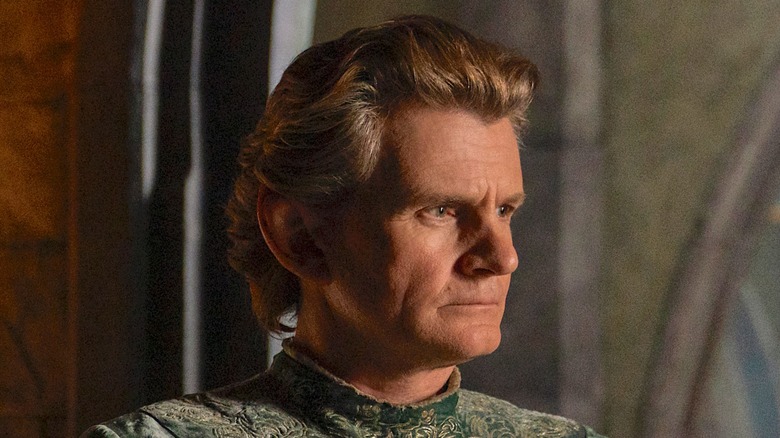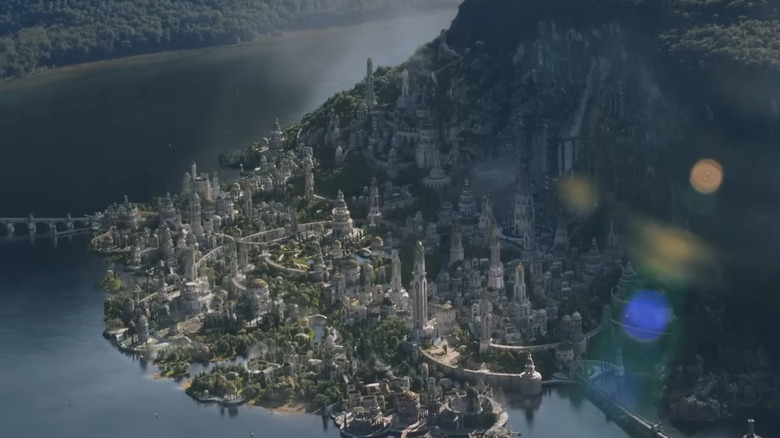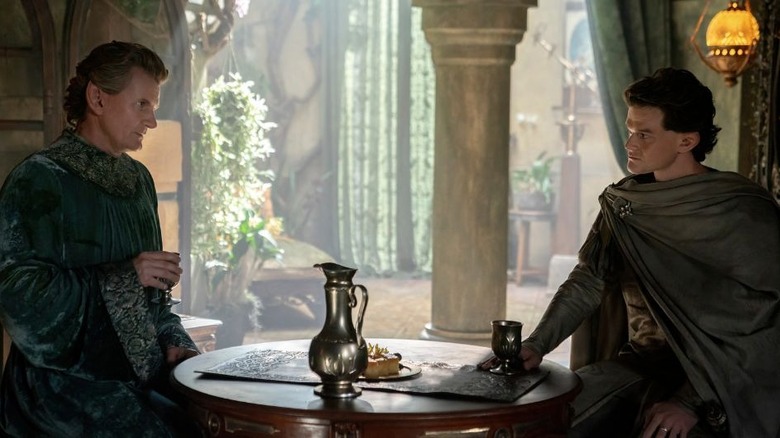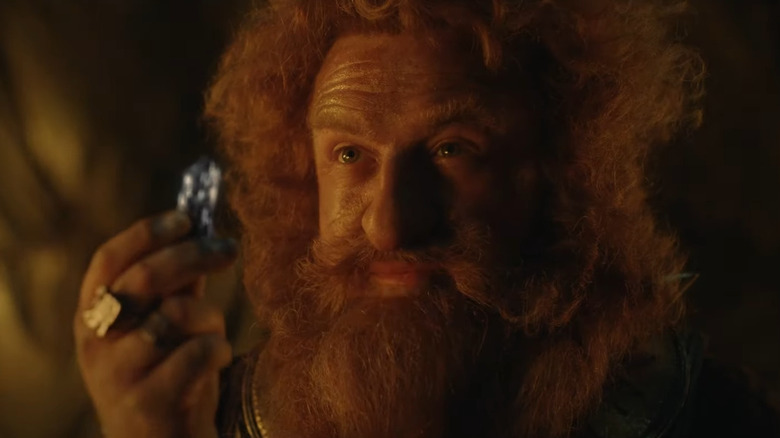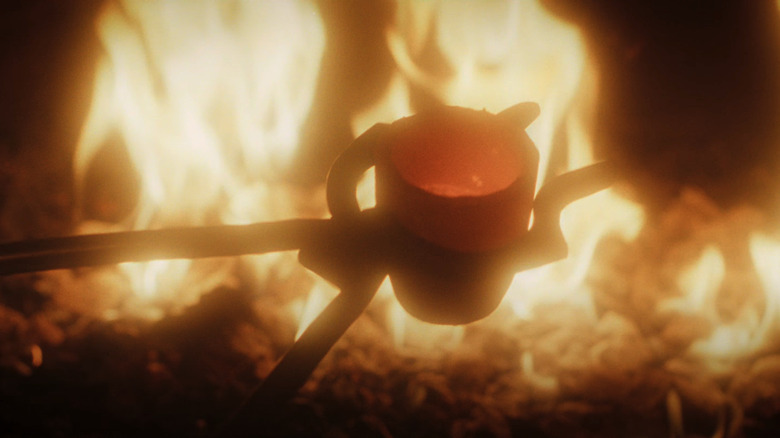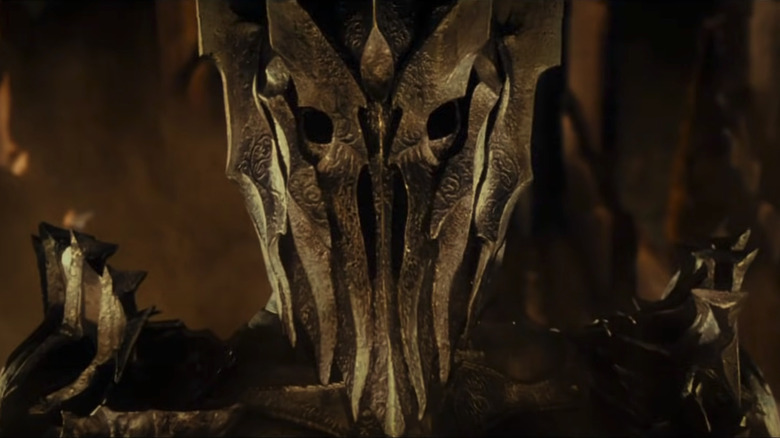The Lord Of The Rings: The Rings Of Power's Eregion Explained
"The Lord of the Rings: The Rings of Power" is an ambitious series set in the Second Age of Middle-earth history. This puts it thousands of years before the events of "The Hobbit" and "The Lord of the Rings," which means audiences will be seeing a very new — though still Tolkienian — landscape.
Some areas will be similar yet different. For instance, the green Southlands in the new series overlap with the desolate area that will sooner or later be known as Mordor. The Elvish area of the Grey Havens in "The Lord of the Rings" is the thriving nation of Lindon during this time, too. One area that will be fairly new to audiences is the glorious kingdom of Eregion. The area only exists in a ruinous state during the later stories, but during Amazon Prime's show, it is at the peak of its beauty.
Eregion isn't just a wonder to behold during the Second Age. It also plays a central role in the events of that era. Here is a quick rundown of the history of the Elvish region — complete with spoilers, so be warned.
Eregion is founded in the Second Age
Unlike most Elven kingdoms, Eregion has a very distinct period of time on the Middle-earth map. According to the timelines that Tolkien provided at the end of "The Return of the King," the area is founded precisely 750 years into the age. It's situated in an area just east of the then-thriving Dwarven kingdom of Khazad-dûm. The proximity isn't a coincidence, either.
Eregion is founded by a group of Elves called the Noldor. They're famous for their near-obsessive interest in crafting. They create all kinds of splendiferous jewels, artifacts, weapons, buildings, and other fascinating works of art. It should come as no surprise, then, that Eregion is founded near the craft-happy Dwarves of Moria — especially because, at this point, the Dwarves have recently discovered a new precious metal. That's right, it's in the Second Age that Dwarves start mining mithril. The appendix explains that "Later some of the Noldor went to Eregion, upon the west of the Misty Mountains, and near to the West-gate of Moria. This they did because they learned that mithril had been discovered in Moria."
So, a bunch of Noldor Elves hear about this marvelous new material, pack up, and literally go found a nation next to the only source of Middle-earth mithril available. They found a capital city called Ost-in-Edhil, which means "Fortress of the Eldar," and before long, they're up and running. They also create a master treasury of sorts called the "House of the Mírdain" to house their many creations.
Celebrimbor and the People of the Jewel-smiths
Trying to explain Eregion's leadership structure is a bit of a challenge. The area doesn't necessarily have a monarch, like the High King Gil-galad in the distant Elven kingdom of Lindon or the Dwarven King Durin III of nearby Khazad-dûm. Its leader is a guy named Celebrimbor, and he's in charge for a couple of different reasons.
First, Lord Celebrimbor is the grandson of the famous (or more accurately, infamous) Elvish leader Fëanor. Fëanor is, for lack of a better word, a jerk. He's aggressive, moody, and makes some really bad decisions early in Middle-earth history. But he's also the greatest Elvish craftsman to ever live — and we all know how important jewelry and crafts and all that stuff were to Tolkien and his world. His grandson, Celebrimbor, inherits this impressive skill, but he rejects his ancestor's poor political taste.
Instead, Celebrimbor focuses on becoming the greatest craftsman of the Second Age — which is the other reason why he's so important in Eregion. The area is filled with artisans and craftsmen who have respect for others with similar skills. That's why the inhabitants of the region are literally called the Gwaith-i-Mírdain, which "The Silmarillion" translates as, "'People of the Jewel-smiths', name of the fellowship of craftsmen in Eregion, greatest of whom was Celebrimbor son of Curufin."
Between his royal heritage and his incredible skillset, Celebrimbor becomes the Lord of Eregion ... even if Tolkien never really clarifies if he's, like, a king or governor or something along those lines. From day one in Eregion, the emphasis is always on craftsmanship — not politics.
Connections with Dwarves
One of the defining factors of the people of Eregion is their ability to connect with their Dwarven neighbors. Anyone who's read or watched Middle-earth content for more than a few seconds is aware of how strong the Elvish-Dwarvish antipathy can be. It's a hot-headed quarrel that goes back to the beginning of time.
In Eregion, though, the two peoples finally get on the same page — thanks to their shared interest in craftsmanship, no less. "The Return of the King" appendices explain this, saying, "The Noldor were great craftsmen and less unfriendly to the Dwarves than the Sindar; but the friendship that grew up between the people of Durin and the Elven-smiths of Eregion was the closest that there has ever been between the two races."
Together, the two groups embark on a lot of different projects. They learn a lot from one another, too, to their mutual benefit. The most famous of all of their projects is a hidden entryway that manages to outlast both kingdoms ... and go on to play a central role in "The Fellowship of the Ring." We're talking about the Doors of Durin. These are the "say friend and enter" doors that glow in the moonlight and let the Fellowship of the Ring enter Moria. Celebrimbor and a Dwarven craftsman named Narvi (who are best buds, by the way) work together to create the magical entrance, and it becomes one of the most enduring signs of friendship between the two groups.
Making rings of power
Eregion spends several centuries blossoming and growing. Its people bond with the Dwarves of Khazad-dûm, and its smiths create bigger and better things. But eventually, they take their quest for crafting glory too far, and it all starts when a pleasant-looking fellow named Annatar shows up from out of nowhere. This ends up being Sauron who has disguised himself in the form of an attractive and kind individual who takes on the title of "Lord of Gifts."
Not every Elf trusts this stranger, but "The Silmarillion" says that "It was in Eregion that the counsels of Sauron were most gladly received, for in that land the Noldor desired ever to increase the skill and subtlety of their works." It goes on to explain that the Elves were restless and wanted to recreate the beauty of the Blessed Realm, which they had left far in the West. It then adds the kicker, "Therefore they hearkened to Sauron, and they learned of him many things, for his knowledge was great. In those days the smiths of Ost-in-Edhil surpassed all that they had contrived before; and they took thought, and they made Rings of Power." Dun. Dun. Dun.
That's right, folks. Eregion is ground zero for the Rings of Power narrative. The Elves, helped by Sauron, create sixteen rings (nine are later given to mortal Men doomed to die and seven to the Dwarves in their halls of stone). Then, Celebrimbor — who really is an impressive craftsman with good intentions — uses his new knowledge to create three ultra-powerful rings without Sauron's help. Finally, the Dark Lord sneaks off and forges One Ring to rule them all in Mount Doom, setting in motion a chain of events that leads to the downfall of Eregion, its people, and Celebrimbor himself.
A brief Elven kingdom
In the end, Eregion's time in the spotlight is intense, passionate, powerful ... and brief. When Sauron creates the One Ring, less than a thousand years after Eregion is founded, the immortal Elves realize what he's done and hide their Rings. Sauron responds by going on the offensive. The first target on his hit list? Eregion. While help is sent by other Elves (including some under the command of Elrond) Sauron is too quick and too strong.
The book "Unfinished Tales" tells us that "At last the attackers broke into Eregion with ruin and devastation, and captured the chief object of Sauron's assault, the House of the Mírdain, where were their smithies and their treasures." The invaders reach their goal, and the tragic fallout of the event spirals from there
Celebrimbor himself fights Sauron on the steps of the treasury, but he's captured and tortured. Sauron discovers where the 16 Rings are, but he never finds out where Celebrimbor sent the Three Elven Rings that he wants the most (hint: Galadriel already has one of them at this point.) When he realizes that he can't get the information he needs, Sauron kills Celebrimbor and hangs his body on a pole, using it as a banner for his armies.
Eregion is destroyed in the carnage, and it never rises again. But we do see it once more. In "The Fellowship of the Ring," the group by the same name travels through an area called Hollin before they reach Moria. Hollin is the name that the Men of Middle-earth use for — you guessed it — Eregion. The group sees some ruins and Legolas talks about how the stones still remember the Elves that crafted them. And that's it. It's a tragic epitaph for one of Tolkien's greatest Elven kingdoms.
